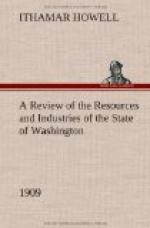[Illustration: Plate No. 63.—Modern Sanitary Dairy Barn, on Farm of Hon. W. H. Paulhamus, Sumner, Pierce County.]
[Illustration: Plate No. 64.—Views in Rainier National Park, Reached by Railroad and Driveway from Tacoma.]
[Illustration: Plate No. 65.—San Juan County Views.]
[Illustration: Plate No. 66.—Purse Seiners’ Camp at Eagle Gorge, San Juan County.]
Resources.
As already indicated, its timber and its fisheries are the great sources of wealth for the county, although stock-raising, dairying, fruit-growing and general farming are constantly growing in importance. [Page 73] The county probably has eleven billion feet of standing timber, and daily cuts with its 64 sawmills about 775,000 feet of lumber and one million shingles.
Both native and cultivated oysters are largely marketed, as are also clams, crabs, shrimp and fish. A splendid market for all farm products is afforded by the mills and lumber camps and summer campers on the beach.
Transportation.
The Northern Pacific railway reaches Willapa harbor, cutting the county centrally east and west. On the long ocean beach from the mouth of the Columbia river northward is a railroad about 20 miles long, made profitable by the extensive patronage of the summer campers. Added to these are the water crafts which frequent the harbor and the Columbia river, and altogether make access to all parts of the county easy.
Cities and towns.
South bend, the county seat, situated near the mouth of the Willapa river, is a rapidly growing town of 3,000 people and destined to become an important ocean port. The harbor is capacious, well protected, has fine anchorage, and is handicapped only by a few feet of mud at the bottom, which Uncle Sam will soon remove. At low tide there is now from 20 to 30 feet of water in the channel of the river and at South Bend it is 1,000 feet wide. South Bend is the terminus of the Northern Pacific railway. It has electric lights, water works, good schools, fine churches, bank, sawmills, planing-mills, sash and door factories, fish canneries, newspapers, etc., and is about to build a $50,000 courthouse.
Raymond, a new manufacturing town on the harbor and railroad, a few miles from South Bend, has 2,500 people and is rapidly growing in importance. Raymond is not yet five years old; has a monthly payroll of $100,000; sawmills and factories representing an invested capital of $4,900,000, employing 1,200 men; an electric light plant; a city telephone system, owned by local capital; a salt-water fire protection system; is about to build two bridges, costing $30,000 each, and is adding new manufacturing plants at the rate of one a month. The city gives free factory sites, and has both rail and ocean transportation from factory locations to the markets of the world.
Ilwaco is a fishing post of importance near the southwest shore of the county, with 900 population.




